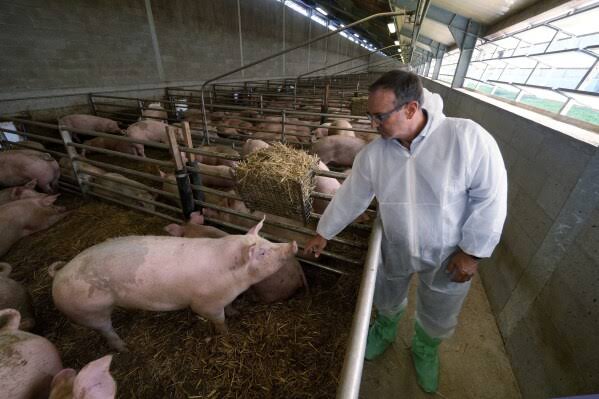Swine fever sweeps Italy’s north, threatening production of prized prosciutto

One of Giovanni Airoli’s sows tested positive for African swine fever in late August. Within a week, all 6,200 sows, piglets and fattening pigs on his farm south of Milan were slaughtered under strict protocols to halt the disease threatening Italy’s 20 billion euro prosciutto, cured sausage and pork industry.
Since swine fever appeared on the peninsula in January 2022, Italy has killed nearly 120,000 pigs — three-quarters of those over the past two months alone as the emergency intensified.”It’s a desolation,” Airoli said outside his farm in the northern Lombardy region that is ground zero for Italy’s swine fever epidemic.
No one is allowed in and out except for employees, and then under strict hygiene protocols that require clean coveralls and boots for use only inside the premises.”It happened to us despite applying all of the safety measures required.
There was obviously a failure. We don’t understand what it could have been,” Airoli said.The disease spiked with 24 outbreaks in early September, most of them in Lombardy.
The area of greatest concern, where the disease has been confirmed in domestic pigs, extends 4,500 square kilometers and includes neighbouring Piedmont and Emilia Romagna, a region world renowned for its prized Parma prosciutto.
The impact of the swine fever outbreak goes further. Farmers in the 23,000-square kilometer area also face restrictions due to infected wild boars, or because they fall in a buffer zone.
The disease, which is nearly always fatal to swine, first infected wild boars and quickly spread to domestic pigs, which number 10 million in Italy. It does not affect humans.
Coldiretti, Italy’s powerful agricultural lobby group, estimates damage to the industry so far at 500 million euros ($554 million), partly due to import bans, and warns that some farmers risk losing their livelihoods.
According to its calculation, the sector generates 20 billion euros ($22 billion) along the supply chain, from farms where the pigs are raised to factories where ham is cured.
“The spread of swine fever has reached alarming levels, putting at risk not just the health of the animals but of the entire pork sector,” Confindustria President Ettore Prandini warned in a recent letter to the agricultural minister.
The government appointed a new special commissioner to tackle the epidemic over the summer, tapping Giovanni Filippini, a trained veterinarian and long-time Italian animal health authority director who eradicated swine fever from the island of Sardinia.
Two previous commissioners focused efforts on dispatching the army to hunt wild boar, hitting resistance from sport hunters and the European Union, which underscored that hunting risked sending infected animals into new areas.Instead, Filippini has imposed new restrictions on accessing farms and transferring animals, and enlarged the buffer zones, measures that seem to be having an impact.
In Lombardy, just one new outbreak was reported during the last full week of September.”It is a positive sign, but not yet a victory,” said Giovanni Loris Alborali, director of the animal health institute for Lombardy and Emilia Romagna. “We must keep the sanitation high and this will help the animals’ health with better growth rates for farmers and fewer antibiotics for consumers in the future.”
As soon as the swine fever was confirmed in Italy, 12 countries, including China, Taiwan and Mexico, put an immediate ban on importing Italian pork delicacies, like prosciutto crudo, no matter if they were produced in an area where swine fever was detected or not. Japan, South Korea and four other countries limited imports.
That brought an immediate loss of 20 million euros ($22 million) a month in exports for a sector that recorded 2.1 billion euros ($2.3 billion) in sales last year, according to the Assica association of Italian meat industries.Markets like the United States and Canada did not stop their imports of pork products, as long as they came from areas not affected by swine fever.
Airoli, who produces ham for both San Daniele and Parma prosciutto, like many other farmers, does not expect to restart his business raising some 13,000 pigs a year until swine fever is brought under control. And there is no indication when that might be.
That’s having an impact on Italy’s prosciutto production.”The limited availability of fresh pork legs is generating strong production limitations,” according to a statement by the Parma Prosciutto Consortium, which produces prosciutto with the certificate of origin designed to protect high-quality foods made by traditional methods.
It added that a spike in prices of the raw materials due to the emergency was also “unsustainable.”Farmers who are still outside the areas of concern are taking extra measures in an effort to ensure the disease does not reach them.
Once detected, all pigs on the farm, even if healthy, must be killed.Sergio Visini, who runs the antibiotic-free Piggy farm in the eastern Mantova province of Lombardy, requires trucks transporting pigs to be sanitized a second time when they enter the sterile zone where the pigs are held.
“We do another detailed sterilization of all of the wheels and any part of the truck that could bring contamination,” said Visini, who opened the farm in 2017 with the aim of raising pigs with less stress and more space.
He hopes more farmers will adopt his methods.”This outbreak can also turn into an opportunity to improve animal health and welfare,” he added.




